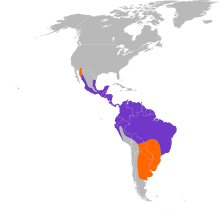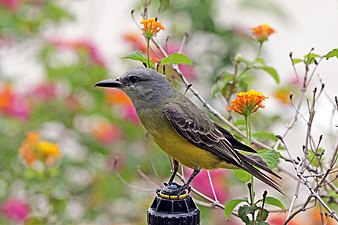Tropical kingbird
| Tropical kingbird | |
|---|---|

| |
| T. m. melancholicus The Pantanal, Brazil | |
| Scientific classification | |
| Domain: | Eukaryota |
| Kingdom: | Animalia |
| Phylum: | Chordata |
| Class: | Aves |
| Order: | Passeriformes |
| Family: | Tyrannidae |
| Genus: | Tyrannus |
| Species: | T. melancholicus
|
| Binomial name | |
| Tyrannus melancholicus Vieillot, 1819
| |

| |
| Purple = year-round range; orange = breeding range | |
The tropical kingbird (Tyrannus melancholicus) is a large
Taxonomy
The tropical kingbird was
Three subspecies are recognised:[6]
- T. m. satrapa (Cabanis & Heine, 1860) – southwest USA to north Colombia, north Venezuela and Trinidad
- T. m. despotes (Lichtenstein, MHK, 1823) – northeast Brazil
- T. m. melancholicus Vieillot, 1819 – north South America to central Argentina
Description
An adult tropical kingbird is 22 cm (8.7 in) long, weighs 39 g (1.4 oz) and has a wingspan range of 38–41 cm.[7] The head is pale gray, with a darker eye mask, an orange crown stripe, and a heavy gray bill. The back is grayish-green, and the wing and forked tail are brown. The throat is pale gray, becoming olive on the breast, with the rest of the underparts being yellow. The sexes are similar, but young birds have pale buff edges on the wing coverts.
Behaviour and ecology
Breeding
Tropical kingbirds appear to be monogamous. In most parts of the species' range, they are permanent residents and remain together in pairs year-round.(Sibley 2014)[page needed] The call is a high-pitched twittering trill, tree-e-e-e-e-e-e, with a more complex version sung by the male at dawn.
Their breeding habitat is semi-open areas with trees and shrubs, including gardens and roadsides. Tropical kingbirds like to observe their surroundings from a prominent open perch, usually high in a tree, undertaking long flights to acrobatically catch
The male and female inspect potential sites together before selecting a site, typically a fork or crotch high in a tree (up to 20 m (66 ft) high) but sometimes just a few metres above water.(Sibley 2014)[page needed] The female builds a bulky, sloppy-looking, shallow nest of vines, rootlets, twigs, weeds, and grasses; it is unlined or lined with hair. Nests average about 13.2 cm (5.2 in) across and 7.6 cm (3.0 in) tall, with interior cup about 7.6 cm (3.0 in) across and 4.1 cm (1.6 in) deep.[15][page needed]
The female incubates the typical clutch of two to four eggs for approximately 16 days, and the nestlings fledge in another 18 or 19 days. The eggs are whitish or pale pink with variable amounts of dark blotching.[15][page needed]
Status
The tropical kingbird is one of the most widespread and conspicuous inhabitants of open forest, forest edge, scrub and agricultural land from the southwestern United States south to Argentina (Jahn, Stouffer, & Chesser, 2013). As a result, the bird is considered as being of Least Concern and their population is increasing, according to the
Gallery
References
Citations
- ^ . Retrieved 19 November 2021.
- ^ Vieillot, Louis Pierre (1817). Nouveau dictionnaire d'histoire naturelle, appliquée aux arts, à l'agriculture, à l'économie rurale et domestique, à la médecine, etc (in French). Vol. Tome 35. Paris: Deterville. pp. 84–85.
- ^ Azara, Félix de (1805). "Num. CXCVIII Del Suirirí-Guazú". Apuntamientos para la historia natural de los páxaros del Paragüay y Rio de la Plata (in Spanish). Vol. 2. Madrid: Imprenta de la Hija de Ibarra. p. 152.
- ^ Traylor, Melvin A. Jr, ed. (1979). Check-List of Birds of the World. Vol. 8. Cambridge, Massachusetts: Museum of Comparative Zoology. p. 223.
- ISBN 978-1-4081-2501-4.
- Rasmussen, Pamela, eds. (July 2020). "Tyrant flycatchers". IOC World Bird List Version 11.1. International Ornithologists' Union. Retrieved 24 May 2021.
- ^ Oiseaux.net. "Tyran mélancolique - Tyrannus melancholicus - Tropical Kingbird". Oiseaux.net. Retrieved 2020-09-26.
- ^ a b Pascotto, Márcia Cristina (2006): Avifauna dispersora de sementes de Alchornea glandulosa (Euphorbiaceae) em uma área de mata ciliar no estado de São Paulo [Seed dispersal of Alchornea glandulosa (Euphorbiaceae) by birds in a gallery forest in São Paulo, southeastern Brazil.]. Revista Brasileira de Ornitologia 14 (3): 291–296 [Portuguese with English abstract]. PDF fulltext Archived 2010-11-02 at the Wayback Machine
- ^ a b c "Tyrannus melancholicus (Tropical Kingbird)" (PDF). Sta.uwi.edu. Retrieved 25 January 2022.
- ^ a b "ADW: Tyrannus melancholicus: INFORMATION". Animaldiversity.org. Retrieved 25 January 2022.
- ^ Basto, Natalia; Rodríguez, Oscar A.; Marinkelle, Cornelis J.; Gutierrez, Rafael & Matta, Nubia Estela (2006): Haematozoa in birds from la Macarena National Natural Park (Colombia). Caldasia 28 (2): 371–377 [English with Spanish abstract]. PDF fulltext
- ^ a b Sibley 2014.
- ^ Partners in Flight 2017.
General sources
- Jahn, A. E., P. C. Stouffer, and R. T. Chesser (2013). T. S. Schulenberg (ed.). "Tropical Kingbird (Tyrannus melancholicus), version 1.0". Neotropical Birds Online. Ithaca, NY: Cornell Lab of Ornithology. doi:10.2173/nb.trokin.01.)
{{cite journal}}: CS1 maint: multiple names: authors list (link - Sibley, D. A. (2014). The Sibley Guide to Birds (2nd ed.). New York: Alfred A. Knopf.
- Partners in Flight (2017). Avian Conservation Assessment Database.
Further reading
- Skutch, Alexander F. (1960). "Tropical kingbird" (PDF). Life Histories of Central American Birds II. Pacific Coast Avifauna, Number 34. Berkeley, California: Cooper Ornithological Society. pp. 349–352.
External links
- "Tropical kingbird media". Internet Bird Collection.
- Tropical kingbird photo gallery at VIREO (Drexel University)
- Tropical kingbird species account at Neotropical Birds (Cornell Lab of Ornithology)
- Interactive range map of Tyrannus melancholicus at IUCN Red List maps
- IUCN. (2019). Tropical Kingbird. Retrieved from: [1]
- Nesting Tyrannus melancholicus




